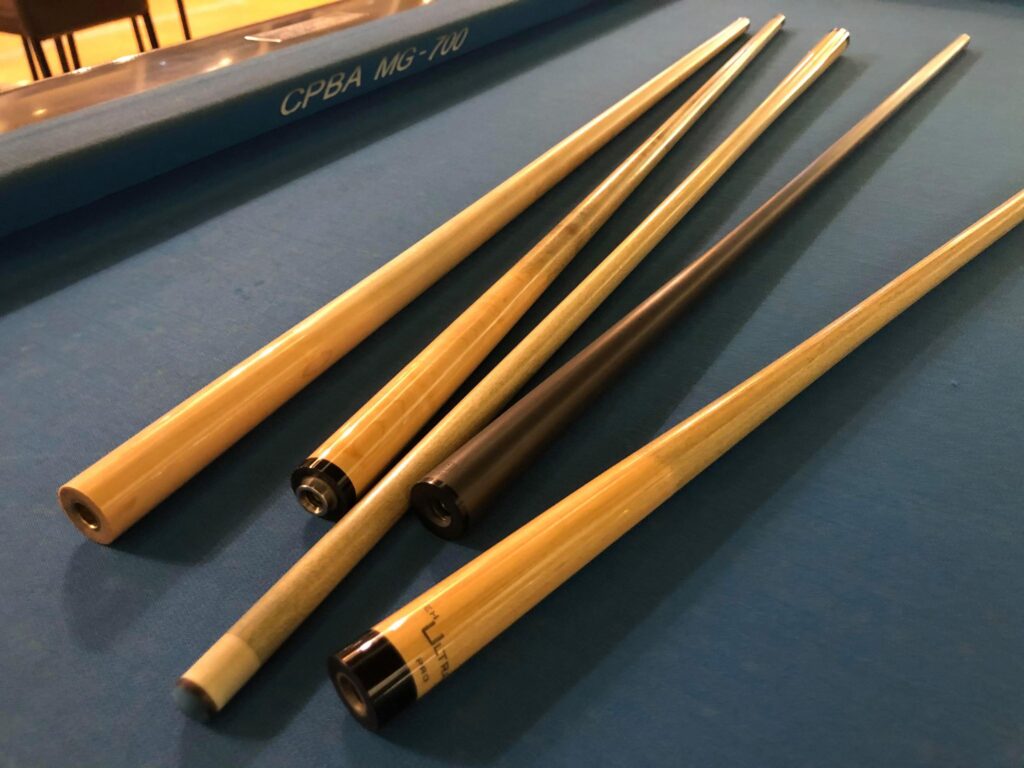When a shaft is at the end of its life, it is
The majority of failures are due to wear on joints.
In this article, I will talk about the “shaft” of the cue.
What is a good shaft?
The answer to this question differs slightly from person to person, but I think most people are looking for something that has the same three elements: white, good wood grain, and solidity.
In particular, white has an image of “clean”, “clean” and “new”, so I think using white shafts makes you feel good just for that.
The material of the white shaft is the outside of the wood.
This part is still alive and well in the early days and can bend with changes in temperature and humidity.
That’s why when I make a shaft, I dry it thoroughly to prevent it from bending before using it.
On the other hand, the inner part of the wood, called the “core wood”, is slightly tinted and inferior to the outer part in terms of whiteness.
But it’s packed with fruit, so it won’t grow any further.
This may not look good, but a slightly tinted shaft is actually less likely to be bent or misaligned because of the core material used.
He added, “The shaft won’t stay white any time soon. It’s not just a matter of being able to keep up with the changes and stability, it’s also a matter of being able to keep up with the changes and stability of the shaft.
I think that’s a reasonable way of thinking, and even if it’s not so extreme, there are a lot of people who think that “cues are nothing but dirt”.
Personally, though, I don’t like my shafts to be dirty, so I clean them to keep them as white as I can tolerate, even if I can’t keep them in new condition.
Some people use sandpaper to clean the shaft.
However, sanding will chip away at the wood, change the condition of the shaft, and shorten its life.
The end of a shaft’s life is mostly due to wear and tear on the joints, except for bending due to poor storage.
The leading edge can be replaced even if it is broken, so as long as there is no wear or rattle in the joint, the shaft will last much longer than before.
And yet, I don’t think you’re going to reduce the life expectancy from yourself by using sandpaper.
The one I use to clean the shaft is an eraser.
I tried various types of erasers, such as the ones that round up the kerbs, but all of them are fine, except for sand erasers, which are very common.
I recommend it because it doesn’t chip the wood, and it removes chalk dust and dirt.
However, please be careful not to contaminate the billiard room with eraser scum.
The advanced players can hear the sound of the crowns
I can tell if you’ve hit the ball in a different way than usual.
The reason you want to keep your whiteness isn’t just “I want to use a clean shaft”.
If you are an advanced player, you have a huge amount of images of play in your mind, and your mind and body naturally react to the images (placement) of the moment, such as “this is how I’m going to get this placement”.
This is a similar ball to the previous one, so you should play it in a similar way.
In fact, I think it’s very difficult to win a professional-level match if you have to think about how to get the ball every time you play.
So, on the flip side, if the video looks the same all the time, the accuracy and averages will go up.
Of course, the arrangement is different every time, so it can’t always be the same image.
But it’s always the same with the ball of the hand and the shaft (cue tip) in sight when you’re poised.
At that time, I think there is a difference in the average if you can always see the same whiteness shaft, or if you can see different colored shafts such as blue or black on different days.
If you are an advanced player, you can tell if you have done something different by the sound you hear when you hit it.
That kind of sensory input is important, and it’s the same reason I always maintain my own whiteness.
Like a pillar in an old European temple.
It’s characterized by the presence of “entasis.
Each person’s preference is also expressed in the tip, but basically, I think it is good to trust and use the tiper as it is sold.
For pocket billiards, “Straight tip”.
This tip is a remnant of the “Coolmans tip” invented by Raymond Coolmans, the “god of billiards” in Carroll.
These are the result of a long period of debate and testing between cue makers and professional players, so there’s no doubt about it.
The Coolmans tip is a tip that was popular about 30 years ago.
It is characterized by the presence of “entasis” (*) like the pillars in the old European temples.
This means that when you hit the end of the ball, the shaft won’t bend too much and you’ll be able to hit the ball well.
Before the Coolmans tip was popular, the balkline and cardle games were the mainstay of the game, so the diameter of the leading edge of the tip at that time was about 11mm in order to hit a fine ball.
The reason for this is that if the leading edge is too thick, you won’t know where you’re hitting.
Also, many players played with two or three fingers on the cue and their wrists, so the tip was straight, like today’s pocket billiard shafts.
After that, the three cushions became the main game, but as before, if you have a thin tip or leading angle, you don’t have enough power or stiffness to hit the three cushions.
I think that’s why Courmans came up with the Courmans tip, which fleshes out the thin parts and gives them entasis.
In 50 years, we will have synthetic and recyclable materials in the queue.
I’m going to have to use it.
Now, like laminated tips, there are “high-tech shafts” that are made by laminating or incorporating artifacts into the shaft.
High-tech shafts are characterized by their high resilience.
It’s like when the pole vaulting pole was changed from bamboo to fiberglass or something like that, and the record has increased dramatically, and the power and rotation have increased, making it easier to cue.
In that sense, it is an evolved tool, and no wonder it has become a hit product.
However, the expansion rate is different for each material, as we also bond the raw material called leather.
So, even though it’s made with considerable precision, I don’t think it’s easy to perfectly laminate wood with resin or other artifacts.
This is the same for wood-to-tree upholstery.
As with leather, no two trees are exactly alike in this world, so I don’t think we can say for sure that there will be no gaps between the upholstery on a semi-permanent basis.
I think the idea of upholstery is great, and the performance is pretty high.
But in terms of stability, I think it’s difficult to increase the stability to the limit when the material is wood, because it’s raw.
Therefore, I personally think that it would be better to use compressed paper or artificial materials that are difficult to change or get caught in the hand, rather than wood, in order to maintain stability and uniformity.
Since ancient times, humans have lived their lives with the warmth of wood.
I’m reluctant to live in a house that doesn’t have wood or wood grain, and that’s the same when it comes to queues.
Even though it is said to be high-tech, we are still seeking and using wood.
But from now on, we have to protect the forest more than ever before.
So in 50 years, I think we will be forced to use synthetic or recyclable materials in our queues.
‘In the old days, the shafts were made of wood…’ he said nostalgically.
In that respect, today’s high-tech shafts are still in the process of being researched.
If this is a world where artificial materials are commonly used by the general public, then I think that high-tech shafts made of artificial materials will also be accepted.
A bulge in the middle of a cylinder that tipers as it goes up.
It is often found in the columns of huge buildings.
Horyu-ji Temple is famous for the Toin temple corridor and Parthenon temple.




